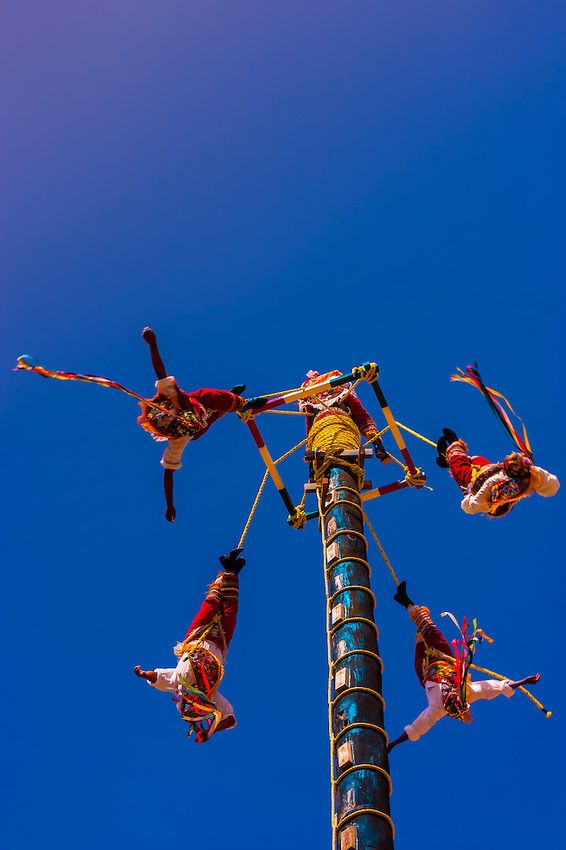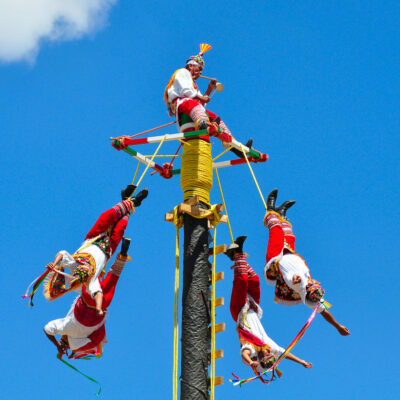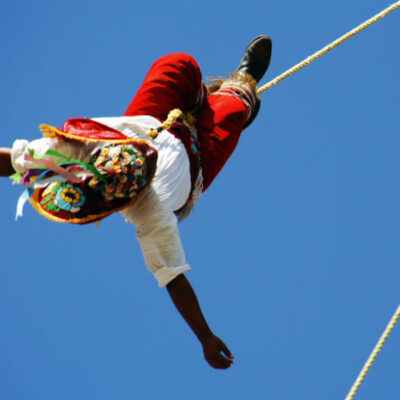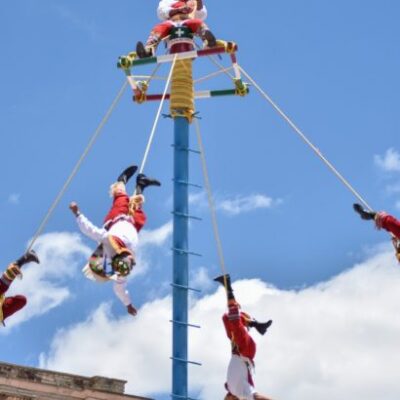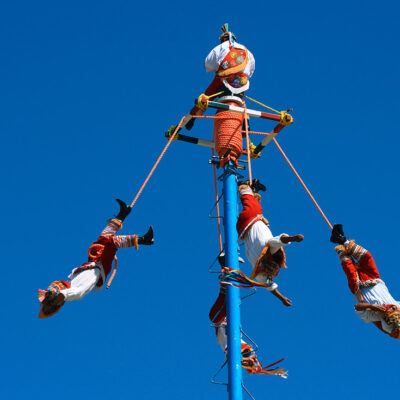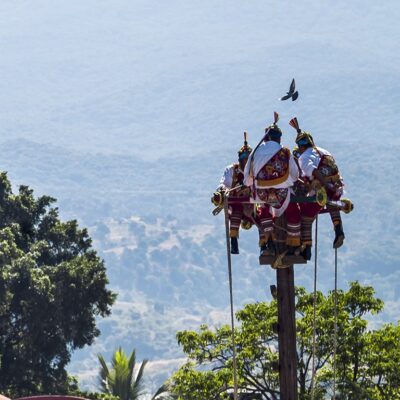LOS VOLADORES DE PAPANTLA
| Los Voladores de Papantla (tour Israel) | ISRAEL, RISHON LE ZION Mayo/2011 |
LOS VOLADORES DE PAPANTLA
The Center for Indigenous Arts is located in Papantla, Veracruz, Mexico; its actions are primarily undertaken at the headquarters at Parque Takilhsukut, just one kilometer from the archaeological site of El Tajin (UNESCO World Heritage Site, 1992). The Park is a cultural complex housing various social, traditional and artistic Totonac organizations, including the CAI itself, thus becoming a space designed to promote the preservation and sustainability of intangible cultural heritage and to train creators from indigenous cultures. Both teachers and students are from the Totonacapan region that encompasses the municipalities of Papantla, Gutiérrez Zamora, Mecatlán, Chumatlán, Poza Rica, Tecolutla, Tihuatlán, Zozocolco de Hidalgo, Coatzintla, Cazones de Herrera, Coahuitlán, Coxquihui, Coyutla, Espinal and Filomeno Mata, in addition to other municipalities in the state of Puebla. The CAI, through its members and the work of the Houses-Schools, has ties to more than 50 communities.
The artistic and traditional organizations linked to the CAI are: the Supreme Totonac Council, El Napuxkun Lakgkgolon (Council of the Elders), organizations of Voladores, including The Ritual Council of Voladores with the participation of Kogsni, the Union of Dancers and Voladores from Papantla, Tutunaku, Organizations of Traditional Healers and Potters, Organizations of Embroiderers, Groups of Traditional Cooks, and a great number of traditional artists.
At the CAI there is broad participation from grandparents (elders), children, young people, women, artists, researchers, members of academia, students and some 100 traditional teachers as well as more than 1,000 students and apprentices from the Center itself. Participating communities include, among others: El Zapotal, Ojital Viejo, El Tajín, El Cedro, Santa Agueda, Agua Dulce, El Remolino, Plan de Hidalgo, La Laguna, La Concha, Mecatlán, Coyutla, Vicente Guerrero, Serafín Olarte, Las Cazuelas, El Volador, Gildardo Muñoz, Morgadal, Plan del Palmar, Espinal, Ojital Nuevo, San José de las Lajas, El Chote, Coatzintla, Papantla, San Antonio Ojital, Tihuatlán, Totomoxtle, Poza Larga, Escolín, Coxquihui, Polutla, Cerro del Carbón, Chumatlán, Tunkuhuiní, Coxquihui and Poza Rica.
The Center for Indigenous Arts answers to age-old demands of the original people: the creation of an educational institution designed to safeguard cultural heritage and its concepts and forms, the projection of artistic and cultural dimensions as part of regional development, and preserving the essence and depth of the ancient teachers. In sum, it enshrines artistic education to shape hearts and to be better human beings.
In July of 2006, the first of many work meetings was held for the construction of the Center; teachers, grandparents, guardians of tradition, cultural promoters, authorities and Totonac artists all took part, as did institutional representatives and those representing social organizations, such as the Supreme Totonac Council, the Academy for Indigenous Languages, the Regional Office for Popular Cultures, the Autonomous University of Veracruz, the Integral Family Development System, and other traditional and cultural bodies.
The CAI, as an educational model, has been built based on the reality of the Totonac people. Those who took part in the initial diagnosis exercise for the construction of the Center indicated that there was no model to follow of a public space for training and teaching/learning of creative Totonac practice, nor was there any recognition of such indigenous creative production, much less any interest in teaching it in public schools (“The fire of our culture was dying out”). Until just 50 years ago, teaching took place in the heart of the home, in the communities; children learned art, trade, and important values of life and culture. At present the interest in teaching these and learning them has declined.
By the end of 2006, through work meetings and workshops, the name and objectives were determined. The Totonac people defined their creative practice and its transmission to new generations: the grandparents and traditional teachers would be charged with identifying and developing the gift that each being is endowed with at birth, in such a manner that the Center became a dynamic space for teaching based on their philosophy and mythical thinking, and was linked to the community. At the same time, it was decreed that the Totonac language was to be used for teaching and learning processes for this would be the vehicle to build their own philosophy.
The objectives of the CAI were identified, focusing on:
• Strengthening indigenous identity and safeguarding priceless cultural heritage.
• Providing favorable conditions for indigenous creators to develop their art.
• Strengthening the models for artistic and cultural creation through actions geared toward training and transmitting traditional knowhow.
• Promoting community development through the communities’ own cultural resources.
• Consolidating the Center as a space for intercultural dialogue.
The Center was born from the conviction that the only way to safeguard the cultural heritage of the original people would be under its guidance and through rescuing their collective experience as a civilization and enshrining it in the essence of its teaching. The proposal was to generate an institution for artistic education wherein that which is taught might reflect a live culture.
The CAI promotes ongoing cooperation with creators and cultural agencies from other states of the country and from around the world. Many experiences have been generated to promote intangible cultural heritage from the artistic standpoint, reaffirming the importance of creativity and interculturality of the people of the world:
Cultural Carnival of Valparaíso in Chile, from December 26 through 28, 2008. Totonacapan dance performances and exhibits.
Vocal Migrations in New York, USA, in collaboration with La Mamma Experimental Theatre, January of 2009; theatre and the participation of the Children Voladores.
Australia´s International Indigenous Dreaming Festival, June of 2009. Exchange of rituals, traditional medicine and expressions of new technologies.
Ibero-American Encounter for Artistic Education and Culture, Organization of Ibero-American States, October 2010. The House of Traditional Pottery and the School for Children Voladores were chosen as outstanding experiences in artistic education.
Exchange with the artistic community of Moutier, Jura Canton, Switzerland. Artistic residencies in 2009 at CAI headquarters and participation in the Festival Espace Stand in Switzerland, July 2010.
Rosso Bastardo Fringe Festival and the International Festival of Worlds, June 30 through July 3, 2010, rituals and healing.
Festival Viva Mexico in New Mexico, USA, 2010 and 2011; International Spring Festival and Creative, May 2011, Rishon LeZion, Israel, as well as the closing ceremony of the 22nd Central American and Caribbean Games in Mayagüez, Puerto Rico, on August 1, 2010; the values of the Ritual Ceremony of the Voladores were shared.
